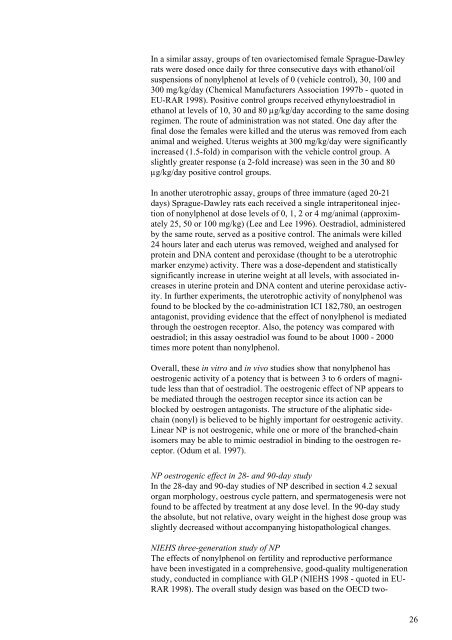Toxicological Evaluation and Limit Values for ... - Miljøstyrelsen
Toxicological Evaluation and Limit Values for ... - Miljøstyrelsen
Toxicological Evaluation and Limit Values for ... - Miljøstyrelsen
- No tags were found...
You also want an ePaper? Increase the reach of your titles
YUMPU automatically turns print PDFs into web optimized ePapers that Google loves.
In a similar assay, groups of ten ovariectomised female Sprague-Dawleyrats were dosed once daily <strong>for</strong> three consecutive days with ethanol/oilsuspensions of nonylphenol at levels of 0 (vehicle control), 30, 100 <strong>and</strong>300 mg/kg/day (Chemical Manufacturers Association 1997b - quoted inEU-RAR 1998). Positive control groups received ethynyloestradiol inethanol at levels of 10, 30 <strong>and</strong> 80 µg/kg/day according to the same dosingregimen. The route of administration was not stated. One day after thefinal dose the females were killed <strong>and</strong> the uterus was removed from eachanimal <strong>and</strong> weighed. Uterus weights at 300 mg/kg/day were significantlyincreased (1.5-fold) in comparison with the vehicle control group. Aslightly greater response (a 2-fold increase) was seen in the 30 <strong>and</strong> 80µg/kg/day positive control groups.In another uterotrophic assay, groups of three immature (aged 20-21days) Sprague-Dawley rats each received a single intraperitoneal injectionof nonylphenol at dose levels of 0, 1, 2 or 4 mg/animal (approximately25, 50 or 100 mg/kg) (Lee <strong>and</strong> Lee 1996). Oestradiol, administeredby the same route, served as a positive control. The animals were killed24 hours later <strong>and</strong> each uterus was removed, weighed <strong>and</strong> analysed <strong>for</strong>protein <strong>and</strong> DNA content <strong>and</strong> peroxidase (thought to be a uterotrophicmarker enzyme) activity. There was a dose-dependent <strong>and</strong> statisticallysignificantly increase in uterine weight at all levels, with associated increasesin uterine protein <strong>and</strong> DNA content <strong>and</strong> uterine peroxidase activity.In further experiments, the uterotrophic activity of nonylphenol wasfound to be blocked by the co-administration ICI 182,780, an oestrogenantagonist, providing evidence that the effect of nonylphenol is mediatedthrough the oestrogen receptor. Also, the potency was compared withoestradiol; in this assay oestradiol was found to be about 1000 - 2000times more potent than nonylphenol.Overall, these in vitro <strong>and</strong> in vivo studies show that nonylphenol hasoestrogenic activity of a potency that is between 3 to 6 orders of magnitudeless than that of oestradiol. The oestrogenic effect of NP appears tobe mediated through the oestrogen receptor since its action can beblocked by oestrogen antagonists. The structure of the aliphatic sidechain(nonyl) is believed to be highly important <strong>for</strong> oestrogenic activity.Linear NP is not oestrogenic, while one or more of the branched-chainisomers may be able to mimic oestradiol in binding to the oestrogen receptor.(Odum et al. 1997).NP oestrogenic effect in 28- <strong>and</strong> 90-day studyIn the 28-day <strong>and</strong> 90-day studies of NP described in section 4.2 sexualorgan morphology, oestrous cycle pattern, <strong>and</strong> spermatogenesis were notfound to be affected by treatment at any dose level. In the 90-day studythe absolute, but not relative, ovary weight in the highest dose group wasslightly decreased without accompanying histopathological changes.NIEHS three-generation study of NPThe effects of nonylphenol on fertility <strong>and</strong> reproductive per<strong>for</strong>mancehave been investigated in a comprehensive, good-quality multigenerationstudy, conducted in compliance with GLP (NIEHS 1998 - quoted in EU-RAR 1998). The overall study design was based on the OECD two-26
















